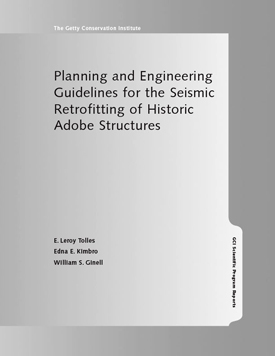
Planning and Engineering Guidelines for the Seismic Retrofitting of Historic Adobe Structures
E. Leroy Tolles, Edna E. Kimbro, and William S. Ginell
2002
160 pages
PDF file size: 4.3 MB
Description
A companion volume to Seismic Stabilization of Historic Adobe Structures: Final Report of the Getty Seismic Adobe Project, this book offers guidance for planners, architects, and engineers in the retrofitting of historic and culturally significant adobe structures. The text outlines the fundamental conservation principles and preparatory steps in the design of a plan. Additionally, it describes the types of earthquake damage typically encountered in historic adobe buildings and presents detailed technical procedures for applying the appropriate retrofit measures. The book also includes a directory of pertinent government agencies, possible funding sources, an abstract of the California seismic safety code, an article describing historic adobe, and excerpts from the Secretary of the Interior's Standards for the Treatment of Historic Properties.
The GCI Scientific Program Reports series presents current research being conducted under the auspices of the Getty Conservation Institute.
Table of Contents
- Foreword
- Acknowledgments
- Introduction
-
Chapter 1: Conservation Issues and Principles
- The Significance of Adobe Architecture in California
- Principles of Architectural Conservation
- Seismic Retrofitting Issues
- Life-Safety Issues
- Conservation Issues
- Retrofitting Objectives and Priorities
-
Chapter 2: Acquisition of Essential Information
- The Historic Structure Report
- Values Identification
- Historic Structure Report Formats
- Minimum Information Requirements
- Summary
-
Chapter 3: Practical Application: Retrofit Planning and Funding
- Preliminary Condition / Structural Assessments
- Choosing the Appropriate Preservation Treatment
-
Chapter 4: Overview of Engineering Design
- Principles of Seismic Design
- The Unique Character of Adobe Buildings
- Stability versus Strength
- Performance-Based Design
- Current Building Codes and Design Standards
-
Chapter 5: Characterization of Earthquake Damage in Historic Adobe Buildings
- Damage Levels in Aseismic Design
- Evaluating the Severity of Earthquake Damage
- Effect of Preexisting Conditions
-
Chapter 6: Getty Seismic Adobe Project Results
- The Retrofit Measures Researched and Tested
- Research Results Summary
-
Chapter 7: The Design Process
- Designing for Earthquake Severity
- Global Design Issues
- Crack Prediction
- Retrofit Measures
-
Chapter 8: Design Implementation and Retrofit Tools
- Standard Lateral Design Recommendations
- Wall Design
- Cables, Straps, and Center-Core Rods
- Case Study 1: Rancho Camulos
- Case Study 2: Casa de la Torre
- Summary of Retrofit Considerations for Adobe Buildings with Walls of Different Slenderness Ratios
- Chapter 9: Conclusions
- Appendix A: Getty Seismic Adobe Project
- Appendix B: The Unreinforced Masonry Building Law, SB547
- Appendix C: California Building Code and Seismic Safety Resources
- Appendix D: Historic Structure Report Resources
- Appendix E: Sources of Information and Assistance
- Appendix F: Federal Standards for Treatment of Historic Properties
- References
- Additional Reading
- Glossary
- About the Authors
- Cumulative Index to the Getty Seismic Adobe Project Volumes
About the Authors
William S. Ginell is a materials scientist with extensive experience in industry. In 1943, after graduating from the Polytechnic Institute of Brooklyn with his bachelor’s degree in chemistry, he became part of the secret research team at Columbia University working to develop the atomic bomb. After the war, he went on to receive his Ph.D. in physical chemistry from the University of Wisconsin, spent nine years at the Brookhaven National Laboratory on Long Island, New York, followed by twenty-six years working for aerospace firms in California. In 1984 he joined the Getty Conservation Institute as head of Materials Science. He is currently senior conservation research scientist at the GCI and was project director of the Getty Seismic Adobe Project.
Edna E. Kimbro is an architectural conservator and historian, specializing in research and preservation of Spanish and Mexican colonial architecture and material culture of early California. She studied architectural history at the University of California, Santa Cruz. Through the 1980s she was involved in restoration of the Santa Cruz Mission Adobe for California State Parks. In 1989 she attended ICCROM in Rome and studied seismic protection of historic adobe buildings. In 1990 she became preservation specialist for the Getty Seismic Adobe Project. Currently, she is the Monterey (California) District historian for California State Parks and prepares historic structure reports for adobe buildings.
E. Leroy Tolles has worked on the seismic design, testing, and retrofit of adobe buildings since the early 1980s, specializing in the structural design and construction of earthen and wood buildings. He received his doctorate from Stanford University in 1989, where his work focused on the seismic design and testing of adobe houses in developing countries. He has led multidisciplinary teams to review earthquake damage after the 1985 earthquake in Mexico, the 1989 Loma Prieta earthquake, and the 1994 Northridge earthquake. He was principal investigator for the Getty Conservation Institutes Getty Seismic Adobe Project and has coauthored numerous publications on seismic engineering. He is principal for ELT & Associates, an engineering and architecture firm in Northern California.